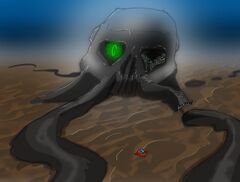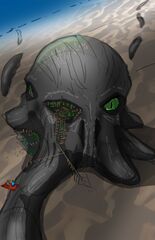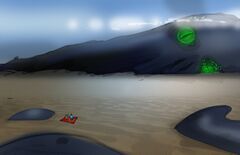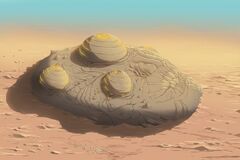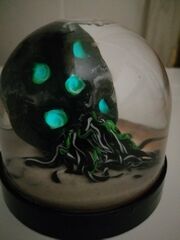A’ctelios Salash
More actions
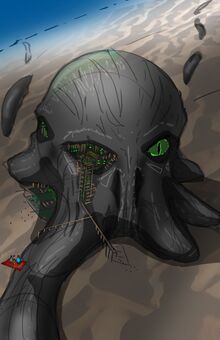
A’ctelios Salash is one of the four Shield Kingdoms of Chandrar. It is also known as The Carven City, Tombhome, or simply A'ctelios. Carved from the corpse of a Seamwalker, A'ctelios Salash is known as the Shield Kingdom that never rots, and has never fallen in battle to invaders, even during the time when Dragons ruled. Despite its infamous reputation, A'ctelios Salash is famous for being a place for trading, as well as its [Fleshshapers] capable of mending all physical maladies.[1]
Overview edit edit source
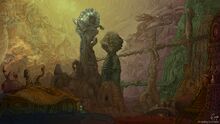
(comissioned by Pirateaba)
Located in southwestern Chandrar, it takes three days of near-constant flight via magical carpet to reach A'ctelios from Germina.
The denizens of A'ctelios harvest the flesh of their home for consumption, once they are of age to willingly choose to eat it. Currently, all five of its eyes, brain and parts of its upper body have been hollowed out and are inhabited by its citizens. There are multiple districts with distinct communities within the great corpse.[2] The flesh never rots, as it is "made of magic and time",[3] and is compared to Dragonflesh, which has some similar qualities.
The residents undergo physical changes from eating the flesh of their home, such as extended lifespans, pointed teeth, or claws. They may also gain the [Fleshchosen] suffix to their class. However, they need to regularly consume A'ctelios's flesh; otherwise their hunger can grow to the point of insanity and start to consume any flesh, living or dead.[4] Inhabitants may reach a second stage of transformation, called a true awakening, and such events are considered cause for great joy and alarm. Those transformed citizens are sometimes sent deeper into the city, and the other Shield Kingdoms are quietly informed. Many true awakenings is a very bad sign.[2]
Origins edit edit source
- “In an age before the Dragons ruled, something came from beyond the edge of the world. It must have destroyed nations. But here it fell. And A’ctelios Salash was the nation that sprang from its corpse. Even when Dragons ruled, they did not take this place. And the people of A’ctelios first sheltered in its eyes. Then, over millennia, dug deeper.”
- - The Quarass
A'ctelios Salash was originally a gigantic Seamwalker[5] from beyond the Edge of the World that came to Chandrar. Its killers were considered heroes, and subsequently began hollowing out its corpse and living inside of it. Initially only settled in the eyes, the people of A'ctelios have slowly carved its way down over millenia. Currently they are settled in the head and halfway down the torso.[3]
Visitor’s Song edit edit source
Old Song edit edit source
“I met a traveller walking on a journey
We stopped where shadows met the sand,
He entered the tomb rotting and I held back
I saw him ever waving, but I never took his hand.”
New Song edit edit source
“We met two folk who stopped on a lonesome path
One entered full of willing, the other did not stay,
A single soul found comfort in our ancient home
He is one of many, and the other slipped away.”
Economy edit edit source
A'ctelios Salash has a vast trading area and traders can enter freely, which makes the city rich. But traders do not stray far or travel below the first layer, due to the city's reputation. Visitors to the city are told not to eat their rotless meat, and the residents are meant to warn them of the risks if they choose to eat it.
They sell meat, leather, and bone. Visiting traders that sell food specify that it's from the outside. Meat from A'ctelios is sold at four coppers for a thick cut, the same price for a Yellat in Reim. Outside of A'ctelios, the meat is taxed for entering by most cities on Chandrar. It is inspected for any bite mark and wrapped until it leaves the city, as per the Pact of A'ctelios. These procedures are also costly, and the guards of the flesh are under magical contract so that if someone eats the flesh in the city without the owner's consent, they would be put to death.
Healing services are offered by [Formshapers], also called [Flesh Mages] and [Fleshshapers], can warp flesh, work with living tissue just as [Necromancers] work with dead tissue. This lets them heal all physical maladies, and they can be hired for this service. They are known to fix birth conditions for the residents.[3]
The people of A'ctelios use Pakheil as beasts of burden and are huge, fleshy beasts that were once people. Becoming a Pakheil is a gamble from eating the meat of A'ctelios, with outsiders having a greater chance of becoming Pakheil than natives. While they are usually respected amongst the people, it is unknown if this is the case in the current cultural climate of Tombhome.[6]
Military Strength edit edit source
A'ctelios Salash is a Shield Kingdom, one of the most ancient nations in the world, tasked with defending Chandrar from Dragons. Eating the meat of the city makes residents more resilient, and change their bodies, forming weapons from their flesh. They are stronger inside their home, able to heal from deep wounds in moments.[3]
The city's narrow passages discourages enemy armies, with it been stated that a million soldiers could break upon A'ctelios Salash.[7] While it does not have a Watch, it does still have designated peacekeepers, outfitted with bone armor and weapons.[3]
A’ctelios supports the Blighted Kingdom with its personnel and flesh so that Rhir's Flesh Reapers can develop the ability to safely consume Demon flesh: They lose their humanity, become extremely tough and more Demon-like in order to fight their Enemy.[8]
There are further levels of transformation, some of which are resistant to spells. Other monsters lie deeper within A'ctelios, which the Scourgeriders could barely kill.[7]
Weaknesses edit edit source
The residents of A'ctelios Salash need to eat the meat of the city regularly. Thus, residents traveling abroad need to have some sent to them, or periodically return in order to get more.
Due to having a high population density, diseases are considered a major problem and is widely feared amongst the denizens.[7]
Chronology edit edit source
During Flos' conquests, he vassalized A'ctelios Salash in a single day and moved on, deciding the city had nothing he wanted.
Volume 7 edit edit source
Trey, Gazi and the Quarass visited A'ctelios Salash in order to heal Gazi's central eye. Afterwards, Trey realises one of the Pakheil was a former Earther, and a video recording showed that he and his group were tricked into consuming the flesh of the city, not given a choice. As the Carven City had betrayed its agreement, they fought their way out. Once outside, they saw that the city's eyes had moved and were looking at them.
A'ctelios Salash declared war on Reim over the alleged murder of their leader Baosar, shortly before Flos declared war on Belchan.
Volume 8 edit edit source
The thousands of Seamwalkers summoned to Kasignel by Norechl, and later the appearance of the Timewalker, was making A'ctelios Salash active again, as it could sense its kin. Fetohep awakened the Scourgeriders of Emrist and rang the Dragonbell to alert everyone of the danger. The Scourgeriders escorted a vessel of poison from Germina carried by Djinnis from Merreid. Once inside, they found that the layout had changed and the spot to deliver the poison could not be found. They thus had to deliver it to a heart or major artery. Every Scourgerider perished to the unknown horrors within the Carven City, but successfully rendered it dormant again. In the process they discovered a strange, horrifying room deep within that was never described in details, except that it was built ten thousand years ago, and they called it treachery and sought in vain to destroy it before being killed by A'ctelios' residents.[7]
Trivia edit edit source
- While A'ctelios Salash was the largest Seamwalker ever recorded by the living, the actual largest Seamwalker is the Timewalker.[9]
- Living Wax was developed from studies in A'ctelios Salash.[10]
Gallery edit edit source
-
A'ctelios by mg
-
A'ctelios from high up, by mg
-
A'ctelios from afar, by mg
-
A'ctelios (draft) by Demonic Criminal
-
A'ctelios in a jar (Project Description), by Mr Momo
